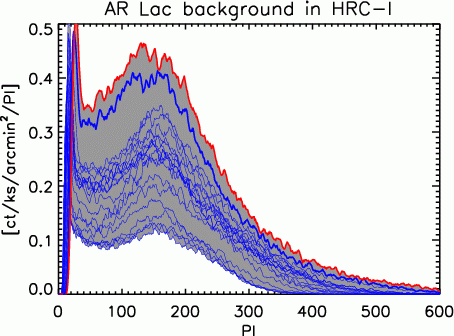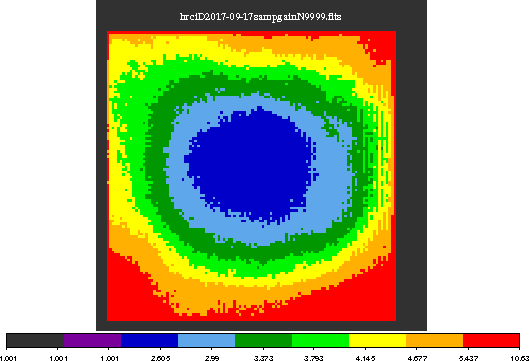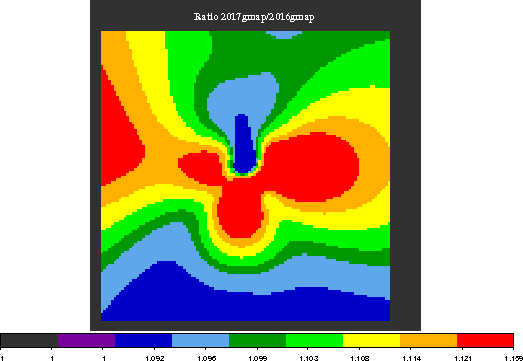CalDB 4.7.7 Public Release Notes
Public Release Date: 14 DEC 2017
SDP Installation Date: 2017-12-14T14:30:00 (UTC)
I. INTRODUCTION
CalDB 4.7.7 is an upgrade to the Chandra CalDB, which includes the following items:
- HRC-I GMAP for 2017-09-17
- HRC-I PIBGSPEC for 2017-09-17
- HRC-I BKGRND Event Lists for 2015-2017
- PIMMS CYCLE 20 Effective Areas
For the CIAO 4.9 / CalDB 4.7.7 release notes see How CalDB 4.7.7 Affects Your Analysis.
II. SUMMARY OF CHANGES
A. HRC-I GMAP for 2017-09-17
| Location: | $CALDB/data/chandra/hrc/gmap/ |
| Filename: | hrciD2017-09-17sampgainN0001.fits |
The September 2017 adjustment to the HRC-I time-dependent gain map has been calibrated and has been released. The rate of gain decay continues to increase with time; however the HRC calibration team has determined that an annual GMAP adjustment is adequate to maintain approximately 2-4% global accuracy in the gain. The same set of ArLac observations has been used to measure the gain corrections. Details including a plot of the new GMAP and its differences with the previous corrections for 2015 are included in the technical details section below.
As with previous HRC-I GMAP updates, these changes will apply only to recent HRC-I observations, specifically those with DATE-OBS later than 2017-09-17T12:00:00 UTC.
See the HRC-I gain map why page for more information.
PIPELINES/TOOLS AFFECTED:
DS and CIAO level 1 (re)processing tool hrc_process_events
Also: CIAO reprocessing script chandra_repro
THREADS AFFECTED:
Reprocessing Data to Create a New L2 Events File
B. HRC-I PIBGSPEC for 2017-09-17
| Location: | $CALDB/data/chandra/hrc/pibgspec/ |
| Filename: | hrciD2017-09-17pibgspecN0001.fits |
Along with the new 2017 HRC-I GMAP, the incumbent PIBGSPEC for September 2017 is also being released. The PI background spectrum changes with the GMAP, because background events reprocessed using the new GMAP, using the point-source observations as are used to generate the new GMAP. This results in a shift in the background spectrum in channel space relative to the previous spectrum file. Details of how the derivation is done, and a plot of the new spectrum in comparison with previous PIBGSPEC files are given in the technical details section below.
PIPELINES/TOOLS AFFECTED:
CIAO tool hrc_bkgrnd_lookup.
THREADS AFFECTED:
HRC-I Background Spectra Files
C. HRC-I BKGRND Event Lists for 2015-2017
| Location: | $CALDB/data/chandra/hrc/bkgrnd/ |
| Filenames: | hrciD2015-01-01bkgrndN0003.fits hrciD2016-01-01bkgrndN0001.fits hrciD2017-01-01bkgrndN0001.fits |
As per the original HRC Stowed Position Background Study, the CalDB is to be annually updated with HRC-I background event lists effective for one full calendar year. As indicated in the contributed page How to Create a Background Map for an Observation, one updated and two more new HRC-I stowed-position background data sets have been compiled and released to users applicable to calendar years 2015 through 2017, respectively. These have been adapted to CalDB and the applicable CIAO thread for generating fluxed images using the BKGRND files. The "time" columns were removed, the EXPOSURE keywords with appropriate values have been added to the headers, along with the CalDB indexing keywords. These are to be added to the existing 15 annually displaced HRC-I BKGRND files already present in CalDB, which extended from 2000 to 2015 previously.
See the HRC-I Background Vignetting why page for more information on use of the HRC-I BKGRND event lists to remove vignetting rings from exposure maps.
PIPELINES/TOOLS AFFECTED:
CIAO tool reproject_events is used to tailor an appropriate HRC-I BKGRND event list to a give observation. The CIAO script fluximage selects the appropriate BKGRND file from CalDB, and uses it to generate background-subtracted fluxed images.
THREADS AFFECTED:
III. TECHNICAL DETAILS
A. HRC-I GMAP for 2017-09-17
The HRC-I gain continues to decline, and at a somewhat accelerated rate since 2010. The Calibration Team is monitoring the situation. At this time, no decision has been made regarding any HV adjustment to recover the detector performance.
The new HRC-I GMAP generated for the (UTC) period 2017-09-17T12:00 to the present, and extending into 2018 is shown in Figure 1a below, with the ratio of the new map to the 2016 map given in Fig 1b. The corrections were generated using G21.5-0.9 and HZ 43 calibration observations taken regularly to monitor HRC-I, combined with a sequence of ArLac observations at 21 specific locations on HRC-I, taken annually. The procedure used to derive the updated GMAPs is given in the publicly-posted document ""SUMAMPS-based Gain Maps for HRC-I", and will not be pressented in detail here.
B. HRC-I PIBGSPEC for 2017-09-17
A corresponding upgrade to the PIBGSPEC library for 2017 has also been derived, effective for the same time-period as the above HRC-I GMAP. The background PI spectra are generated from the same HRC-I calibration observations of AR Lac used to derive the new GMAP. These 21 observations are reprocessed with the new GMAP, generating new PI scaled to SUMAMPS values. The result is illustrated in Fig. 2 below, with the red trace giving the new 2017 bacground spectrum, the bold blue trace is from the 2016 data set, and previous years in various line types for comparison.
For each year, the HRC-I Cal team extracts events in a 800x800 pixel box at the 17 ArLac observation locations that are within 10 arcmin of the aim point, excluding the location of the source. They sum the PI spectra from each location, weighting by exposure time, to create the final PI spectrum for the year. Finally, the PI spectra are Loess-smoothed with a third-degree polynomial fit over ranges 10 channels wide.

Fig. 2: Taken from the Chandra Cycle 20 POG, the red trace is data from the new PIGBSPEC file for 17 September 2017. The bold blue trace just beneath the red one is from 2016.

